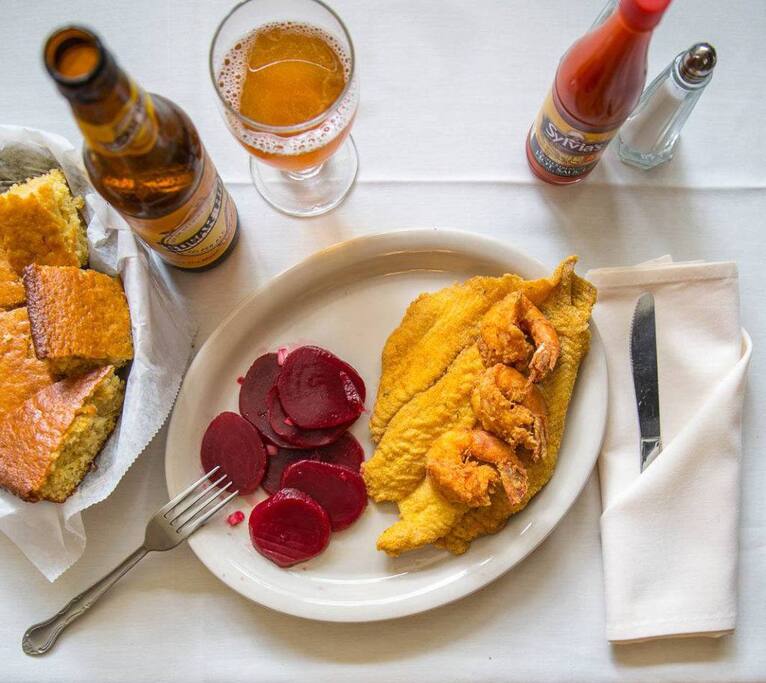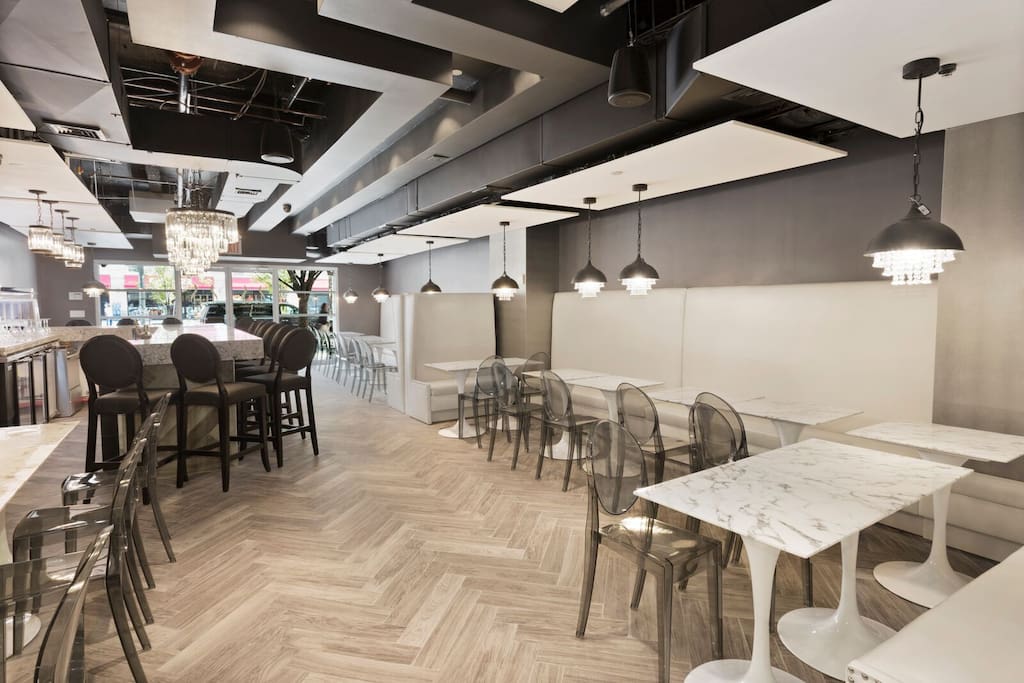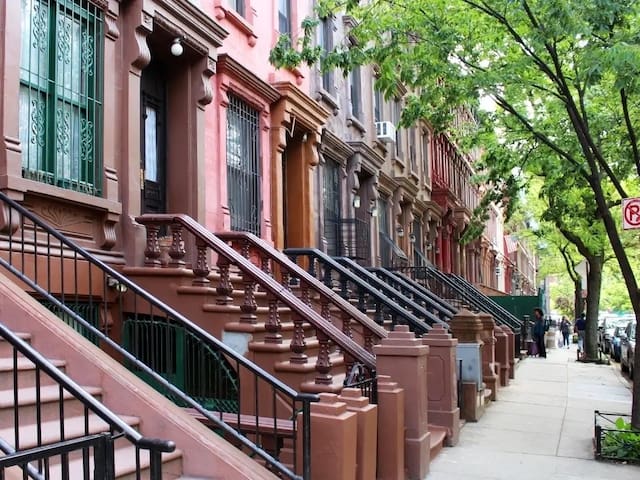Food scene
Harlem landmark. World famous soul food restaurant, 328 Malcolm X Blvd.
405 lokalinvånare rekommenderar
Sylvia's Restaurant
328 Malcolm X BlvdHarlem landmark. World famous soul food restaurant, 328 Malcolm X Blvd.
My favorite late night spot
Great hookah, appetizers, and drinks. 21+ older. Need to show ID for entry.
13 lokalinvånare rekommenderar
Harlem Hookah
387 Malcolm X BlvdGreat hookah, appetizers, and drinks. 21+ older. Need to show ID for entry.
Cute bar
Harlem restaurant/bar with upscale pub menu, craft beers, outdoor seating,
345 lokalinvånare rekommenderar
The Corner Social
321 Malcolm X BlvdHarlem restaurant/bar with upscale pub menu, craft beers, outdoor seating,
Fan favorite
Southern classics served in a retro setting that's relaxed & homey by day, bustling in the evening,
138 lokalinvånare rekommenderar
Melba's
300 W 114th StSouthern classics served in a retro setting that's relaxed & homey by day, bustling in the evening,
Sightseeing
Bill's Place
148 W 133rd StJazz legends play in a small no-frills room
Neighborhoods
Harlem is known internationally as the Black Mecca of the world, but Harlem has been home to many races and ethnic groups including the Dutch, Irish, German, Italian, and Jewish. Harlem was originally settled by the Dutch in 1658, but was largely farmland and undeveloped territory for approximately 200 years. As New York’s population grew, residential and commercial expansion moved northward, and development of the Harlem territory was evitable.
During the 1880’s, elevated rail lines were extended north along Eighth & Ninth Avenues, encouraging expansion northward. Development of transportation lines caused speculation on the land and many fine row houses and multiple family apartment buildings were erected. However, this boom slowed in 1893 when a national recession struck. The recession curbed further developed and stymied real estate sales. When the economy recovered in 1895, development continued, especially in the form of beautiful apartment buildings.
The Lenox Avenue IRT subway line was completed in 1904, and once again many speculated that Harlem would become extremely desirable to those residing in lower Manhattan. Hundreds of tenement apartment buildings were built anticipating the masses from lower Manhattan to occupy them. Unfortunately for the developers, the IRT not only made Harlem available to those from downtown, but also made Washington Heights, the Bronx and other northern points accessible. Developers over speculated and many houses went unsold.
Real estate agent and entrepreneur Phillip A. Payton approached several Harlem landlords with the proposition that he would fill their empty or partially occupied properties with Black tenants. The idea was accepted and Payton began moving Black families into buildings in the 130’s of Central Harlem. Many don’t know Phillip A. Payton, but some consider him to be the father of “Black Harlem”. The house he lived in with his wife Maggie still stands on West 131st Street.
Black people continued to pour into Harlem from points in lower Manhattan, the American South and the Caribbean. With the onset of the First World War in 1915, many foreign immigrants set sail for their homelands, leaving employment opportunities available in the war industries in the north. Blacks migrated in record numbers from the south to northern cities in search of opportunities and increased wages.
During the 1920’s, Harlem flourished with cultural and artistic expression. This period was christened the “Harlem Renaissance”. Harlem Renaissance figures such as Langston Hughes, Aaron Douglas, Alain Locke and others felt that they would use their artistic creativity as a means to show America and the world that Blacks are intellectual, artistic and humane and should be treated accordingly.
The Great Depression of 1929 rocked the country and devastated Black communities such as Harlem. The pressure of high rents, unemployment and racist practices culminated in Harlem riots in 1935 and 1943. The Second World War offered black people few opportunities for advancement, and black people mobilized against the war industry demanding fair practices. Militant activities during the 1940’s set the stage for the1960’s.
Harlem was both stage and player during the turbulent period of the Civil Rights Movement. Religious and political leaders articulated the sentiments of the masses from street corners and pulpits throughout the community. During the 1960’s, figures like Malcolm X, Adam Clayton Powell Jr., Queen Mother Moore and Preston Wilcox used Harlem as a launch pad for political, social, and economic empowerment activities. Social problems caused a decrease in Harlem’s population during the late 1960’s through the 1970’s, leaving behind a high concentration of underprivileged residents and a fast-decaying housing stock.
Despite the rough days of the previous few decades, Harlem is presently experiencing a new renaissance. Unlike the cultural and literary renaissance of the 1920’s, the current rebirth is based in economic development and cultural preservation. A brief walk through any section of the community will reveal the sights and sounds of construction crews at work developing properties. Ex-President Bill Clinton could have established his office anywhere in the USA, but chose Harlem. Tourists from around the world are visiting in record numbers, to absorb the beautiful multi-ethnic culture of the Black capital of America.
160 lokalinvånare rekommenderar
Harlem
Harlem is known internationally as the Black Mecca of the world, but Harlem has been home to many races and ethnic groups including the Dutch, Irish, German, Italian, and Jewish. Harlem was originally settled by the Dutch in 1658, but was largely farmland and undeveloped territory for approximately 200 years. As New York’s population grew, residential and commercial expansion moved northward, and development of the Harlem territory was evitable.
During the 1880’s, elevated rail lines were extended north along Eighth & Ninth Avenues, encouraging expansion northward. Development of transportation lines caused speculation on the land and many fine row houses and multiple family apartment buildings were erected. However, this boom slowed in 1893 when a national recession struck. The recession curbed further developed and stymied real estate sales. When the economy recovered in 1895, development continued, especially in the form of beautiful apartment buildings.
The Lenox Avenue IRT subway line was completed in 1904, and once again many speculated that Harlem would become extremely desirable to those residing in lower Manhattan. Hundreds of tenement apartment buildings were built anticipating the masses from lower Manhattan to occupy them. Unfortunately for the developers, the IRT not only made Harlem available to those from downtown, but also made Washington Heights, the Bronx and other northern points accessible. Developers over speculated and many houses went unsold.
Real estate agent and entrepreneur Phillip A. Payton approached several Harlem landlords with the proposition that he would fill their empty or partially occupied properties with Black tenants. The idea was accepted and Payton began moving Black families into buildings in the 130’s of Central Harlem. Many don’t know Phillip A. Payton, but some consider him to be the father of “Black Harlem”. The house he lived in with his wife Maggie still stands on West 131st Street.
Black people continued to pour into Harlem from points in lower Manhattan, the American South and the Caribbean. With the onset of the First World War in 1915, many foreign immigrants set sail for their homelands, leaving employment opportunities available in the war industries in the north. Blacks migrated in record numbers from the south to northern cities in search of opportunities and increased wages.
During the 1920’s, Harlem flourished with cultural and artistic expression. This period was christened the “Harlem Renaissance”. Harlem Renaissance figures such as Langston Hughes, Aaron Douglas, Alain Locke and others felt that they would use their artistic creativity as a means to show America and the world that Blacks are intellectual, artistic and humane and should be treated accordingly.
The Great Depression of 1929 rocked the country and devastated Black communities such as Harlem. The pressure of high rents, unemployment and racist practices culminated in Harlem riots in 1935 and 1943. The Second World War offered black people few opportunities for advancement, and black people mobilized against the war industry demanding fair practices. Militant activities during the 1940’s set the stage for the1960’s.
Harlem was both stage and player during the turbulent period of the Civil Rights Movement. Religious and political leaders articulated the sentiments of the masses from street corners and pulpits throughout the community. During the 1960’s, figures like Malcolm X, Adam Clayton Powell Jr., Queen Mother Moore and Preston Wilcox used Harlem as a launch pad for political, social, and economic empowerment activities. Social problems caused a decrease in Harlem’s population during the late 1960’s through the 1970’s, leaving behind a high concentration of underprivileged residents and a fast-decaying housing stock.
Despite the rough days of the previous few decades, Harlem is presently experiencing a new renaissance. Unlike the cultural and literary renaissance of the 1920’s, the current rebirth is based in economic development and cultural preservation. A brief walk through any section of the community will reveal the sights and sounds of construction crews at work developing properties. Ex-President Bill Clinton could have established his office anywhere in the USA, but chose Harlem. Tourists from around the world are visiting in record numbers, to absorb the beautiful multi-ethnic culture of the Black capital of America.
Historic American Theater
Maybe the most famous attraction in Harlem, the Apollo Theater was built in 1914 and has hosted thousands of entertainers, musicians, and comedians that elevated African American culture and arts on a global scale
893 lokalinvånare rekommenderar
Apollo Theater
253 W 125th StMaybe the most famous attraction in Harlem, the Apollo Theater was built in 1914 and has hosted thousands of entertainers, musicians, and comedians that elevated African American culture and arts on a global scale



